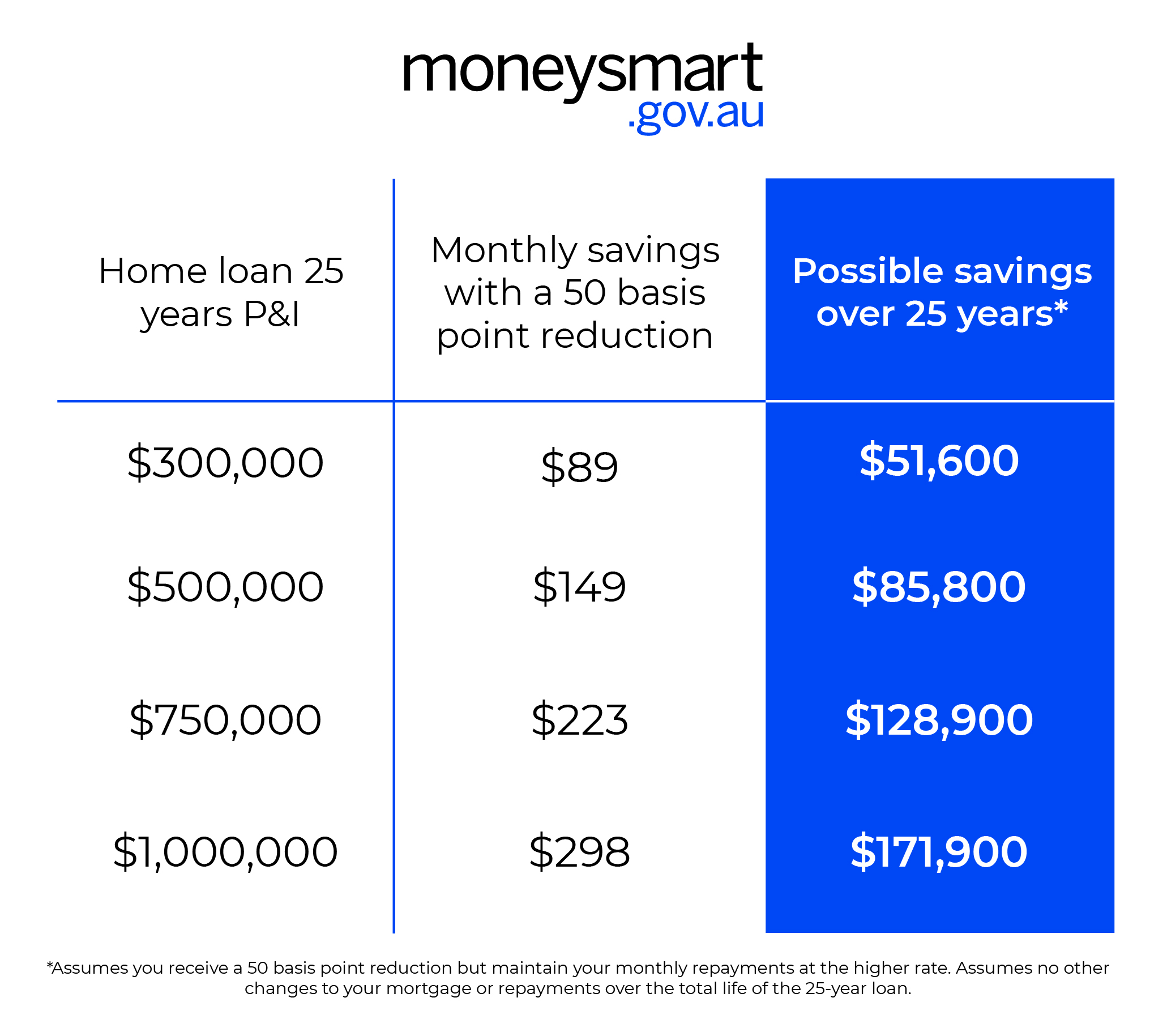There can be an interest rate difference of more than 2% in variable home loan rates on the market. So, it’s worth checking the market from time to time.
Eight times a year the Reserve Bank of Australia (RBA) Monetary Policy Boards meets to decide whether to increase, decrease, or maintain the cash rate. The decision that it makes each time flows through to home loan interest rates.
It’s important to know, though, that the RBA cash rate isn’t the only thing that affects home loan interest rates. The interest rate you’re being charged by your lender could also be based on your personal credit worthiness, your value as a customer and what the competition are offering.
There can be an interest rate difference of more than 2% in variable home loan rates on the market. So, it’s worth checking the market from time to time.
If you're struggling with your home loan repayments, see problems paying your mortgage for help.
What difference could a lower home loan rate make?
Without taking into account fees or features, a 50 basis point (half a percent) reduction in home loan rates – from 5.68% to 5.18% - could potentially make the following difference per month:

This is a simple example - everyone’s situation is different. It’s worth doing some sums based on your own home loan, to compare what you’re currently paying against what you might pay with a lower rate.
Work out your home loan repayments and compare different rates.
What to think about before you switch home loans
Refinancing your home loan to take advantage of a lower interest rate might save you money. Before you switch, make sure the benefits outweigh the costs
1. Ask your current lender for a better deal first
Tell your current lender you are planning to switch to a cheaper loan offered by a different lender. To keep your business, your lender may reduce the interest rate on your current loan.
If you have at least 20% equity in your home, you'll have more to bargain with. Having a good credit score will also help with negotiations.
Compare any loan they offer you with the other loans you're considering. See choosing a home loan for tips on what to look for.
2. Check whether you'll have to pay lender's mortgage insurance
If you have less than 20% equity in your home, you might have to pay lender's mortgage insurance (LMI). This can increase the cost of switching and outweigh the savings you'll get from a lower interest rate.
If you decide to switch, ask for a refund of some of the LMI from your current loan.
3. Check any other fees and charges
A mortgage broker or a comparison website can help you find out what's available.
Comparison websites can be useful, but they are businesses and may make money through promoted links. They may not cover all your options. See what to keep in mind when using comparison websites.
Compare these fees and charges:
|
Fixed rate loan |
|
|
Discharge (or termination) fee |
|
|
Application fee |
|
|
Switching fee |
|
|
Stamp duty |
|
Ask the new lender to waive the application fee to get your business.
4. Be clear on the length of the new loan
If you do switch, be firm on the length of home loan you want. Otherwise you could end up with a longer loan term than the years left to pay off your current mortgage.
The longer you have a loan, the more you'll pay in interest. If you do decide to switch, negotiate a loan with a similar length to your current one.
Check if you'll save by switching
Once you have a short list of potential loans and the fees involved, use the mortgage switching calculator to work out if you'll save money by changing home loans. It also shows how long it will take to recover the cost of switching.
Check out how much you'll save by changing home loans.

Simon and Tiana consider refinancing
Simon and Tiana's fixed rate home loan period ends in a few months and their interest rate will increase. They decide to see what other lenders are offering.
They find two loans with a lower interest rate and the features they want.
Loan A has an application fee of $600 and Loan B has an application fee of $300. Simon and Tiana decide to pick Loan A because it has the lowest interest rate, which offsets the higher establishment fee.
By switching loans they will save $84,040 ($280 a month) over the life of their 25-year loan. They will recover the switching costs in five months.